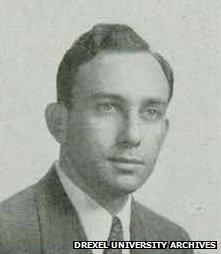Barcode co-inventor Norman Joseph Woodland dies aged 91
- Published

Woodland died at his home in New Jersey on Sunday, his daughter said
Norman Joseph Woodland, who co-created the barcode, has died at his New Jersey home at the age of 91.
Woodland worked with university classmate Bernard Silver to create the now ubiquitous thick-and-thin-line system in the 1940s.
The system was patented in the US in 1952, a patent that was later sold for just $15,000 (£9,300).
The modern-day barcode is estimated to be scanned more than five billion times every day.
Atlantic City-born Woodland died on Sunday, his daughter told the New York Times, external.
Woodland's efforts were years ahead of their time. It took 22 years for the invention to make its first appearance in a US shop - due to the fact the laser technology required to read the lines did not exist.
The first item scanned was a packet of chewing gum in an Ohio supermarket in 1974.
Four fingers
Woodland is said to have conceived the barcode while sitting on a chair surrounded by sand.
With Morse code in mind, Woodland began to draw with his fingers.
Speaking of that moment, he told Smithsonian magazine in 1999: "I poked my four fingers into the sand and for whatever reason — I didn't know — I pulled my hand toward me and drew four lines.
"I said: 'Golly! Now I have four lines, and they could be wide lines and narrow lines instead of dots and dashes.'"
The patent was sold to battery storage company Philco - but expired in the 1960s, allowing IBM - where Woodland was working - to finalise and tweak the design into something we recognise today.
In 2011 both Woodland and Silver were inducted into the US's National Inventors Hall of Fame.
- Published7 October 2012